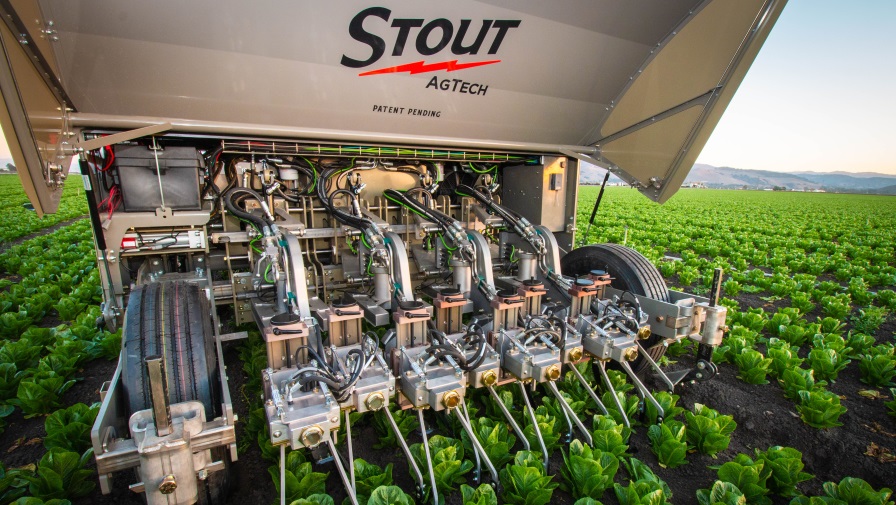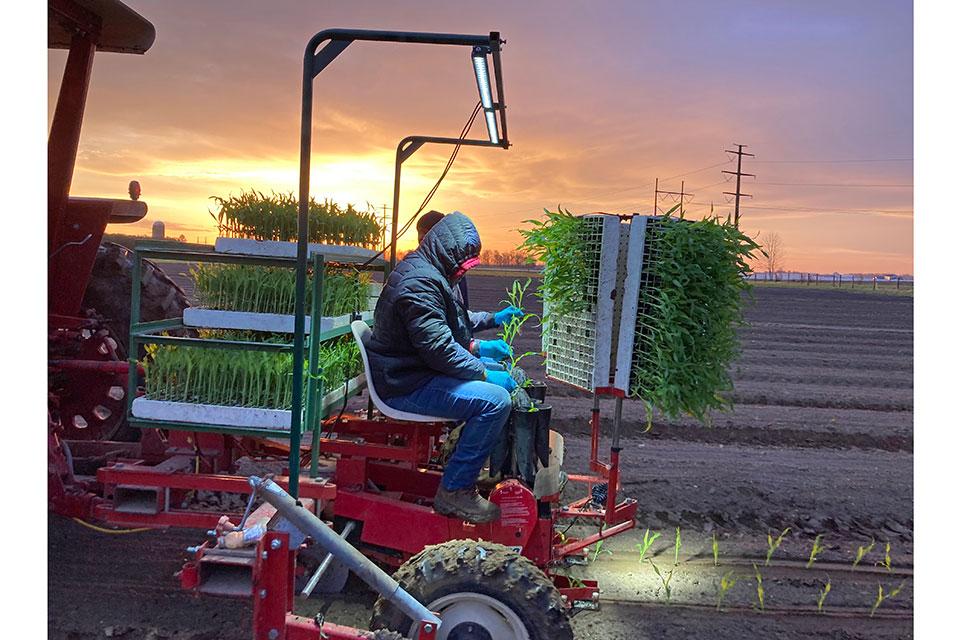Pruning Pointers for Dormant Care of Berries
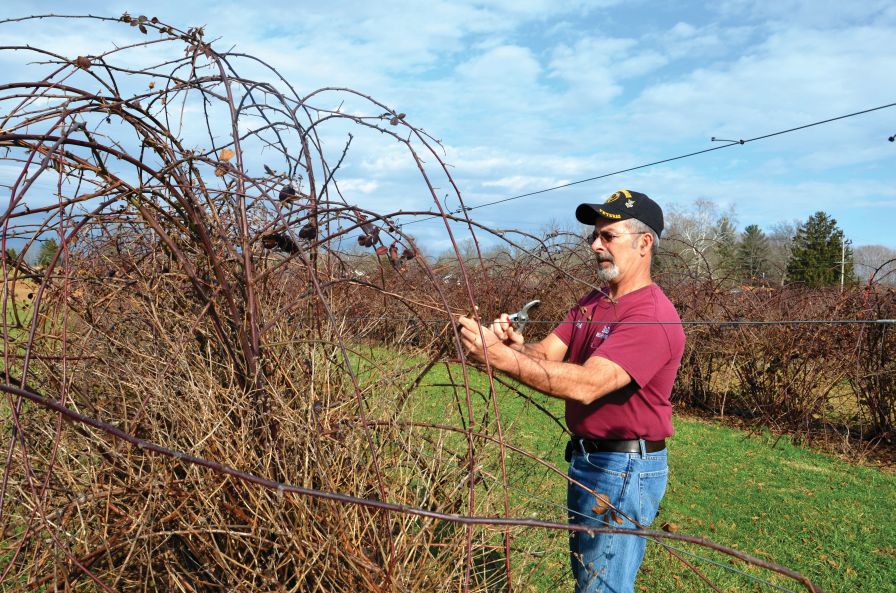
Richard Burke of B&D Berry Farm in Peebles, OH, says ‘Triple Crown’ pruning starts in early March and he wants the plants to be level at the top of the trellis. (Photo credit: Gary Gao)
Dormant pruning of blackberries and blueberries can take on different forms and approaches.
When this article reaches your mailbox, computer, coffee table, or your beautiful truck, you should have done quite bit pruning already. If yes, great! If not, it’s still all good, unless you have tens of thousands of plants to prune!
When I visited several blueberry growers in northern Indiana a few years ago, some of them started pruning their blueberry bushes in October. This was due to the sheer number of bushes and limited labor.
They had to start dormant pruning earlier than most. Otherwise, the pruning work would not have been completed by late March. If you have a small berry patch, you could afford to procrastinate a little, until now.
However, dormant pruning is absolutely essential. The main goals of dormant pruning are to remove excessive fruiting wood, open up the bush canopy, remove old and diseased canes, and ultimately improve fruit quality and plant health. I always tell our growers I am “comparing notes” with them since there is always more than one way to get the job done right.
The Approach to Blackberries
Let’s talk about pruning blackberry plants first. I got to visit with Richard Burke of B & D Berry Farm in Peebles, OH, in late January. This weather was unseasonably warm. Dressed in jeans and a T-shirt, Mr. Burke demonstrated how he prunes his ‘Triple Crown’ blackberry bushes. Since blackberry plants can sustain quite a bit of winter injuries, it is a good idea to wait until March to prune thornless blackberry bushes.
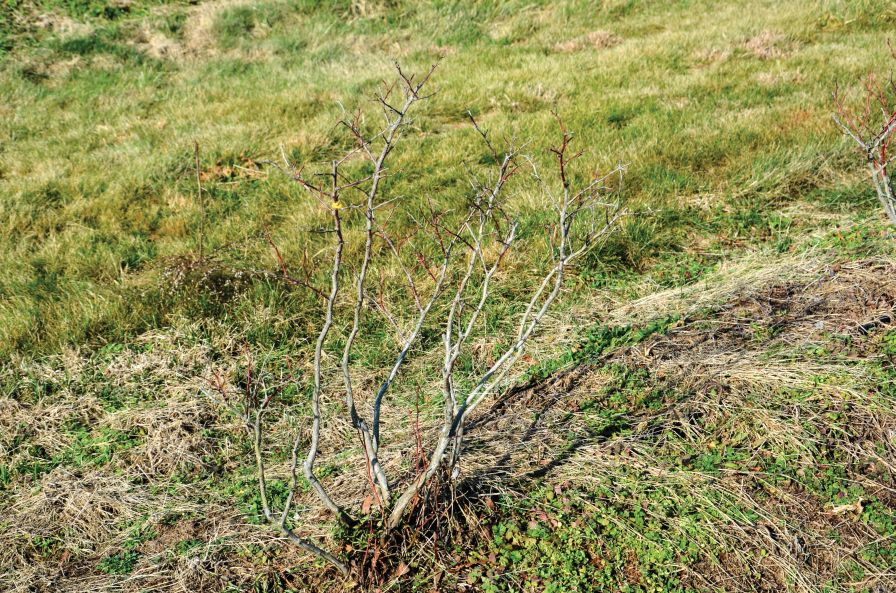
A young and weak ‘Draper’ blueberry bush will benefit from severe dormant pruning to promote shoot growth. (Photo credit: Gary Gao)
“Pruning blackberries is a never-ending undertaking. At B & D Berry Farm, we have nearly 1,000 ‘Triple Crown’ blackberry plants, six years old during the 2017 season,” he says. “At full maturity now, we have found that pruning is best accomplished in early spring. We let the plants grow all autumn, until they completely grow over the 6-foot trellis and down to the ground on the other side.”
Burke learned his pruning techniques by reading books and visiting numerous farms. He developed his pruning method
based on what he learned from others and his own situation.
“In early March, we start pruning the plants to be level at the top of the trellis. In April, we prune the laterals right before they begin to bud,” he says. “This method serves to cut out all winter damage, so that the spring growth is strong and healthy. It also adds the bonus that plants that grow over and touch the ground will begin to root in the spring, allowing us to harvest new plants for replanting, with little effort on our part.”
Keep These in Mind
Burke’s approach should work well on most thornless blackberry plants trained on a hedgerow. I recommend tipping canes to about 4 to 6 inches or about the top wire. Remove approximately 4 inches of the terminal growth during the summer, then new canes reach the top wire.
Tipping of the canes will encourage lateral shoot growth. Laterals will then be shortened to about 1 foot and a foot and half depending on the vigor of the blackberry cultivar. Waiting until March and early April to prune the blackberry plants is a good idea, especially after several years of the bitterly cold winters.
Some growers have planted a few primocane-fruiting blackberry cultivars in the Midwest. These types of blackberry
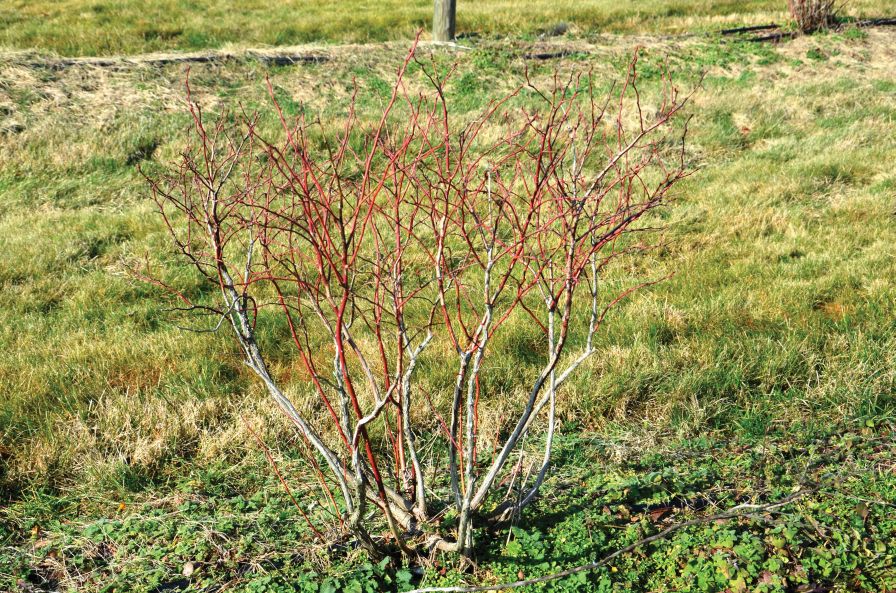
A young and strong ‘Draper’ blueberry bush before pruning. (Photo credit: Gary Gao)
cultivars can be pruned to the ground in March since fruits will be born on new canes or primocanes.
It is important to know your blackberry cultivars, production systems, and training methods since pruning methods can be different. Please refer to the Natural Resource, Agriculture, and Engineering Service’s “Raspberry & Blackberry Production Guide for the Northeast, Midwest, and Eastern Canada” for additional information.
Pruning Blueberries
I would like to switch gears now. Let’s talk about pruning young blueberry bushes. During the first three years, very little pruning is required. I recommend you remove one or two really weak shoots and remove flower buds to reduce and eliminate fruit load during the first two years to allow plants to grow their roots. You should also leave a few high-quality flower buds during the third year for fruiting. Even a strong blueberry bush will benefit from removal of weaker, low-growing, and crossing canes while keeping strong and upright canes.
A weak bush will benefit from much more severe pruning to encourage shoot and root growth. I would cut most, if not all, of the canes off to the ground level to give the plant a chance to grow. It will also be beneficial to check the drip line and emitters to make sure that the plant gets what it needs during the growing season.
Cuts On Mature Blueberries
Pruning mature blueberry bushes gets a little more complicated, but it is still much less confusing than pruning apple trees. A simplified approach is to prune by stem color. I would look for red-colored, strong, upright canes with large and healthy flower buds. Your best fruits will likely come from these canes. You will always want to keep as many of those as possible.
Eliminate Old Wood
I would remove short and weak canes at the base of the plants. After that, it is time to remove two or three older canes with many short and weak stems. These old canes are typically older than four or five years old and are gray in color. Crossing, broken, or diseased branches will be removed next. Canes with many short stems and numerous small flowers buds are nicknamed ‘twig growth’ and should be removed or thinned. Your job might be about done here. Some growers prune even harder, if they are after large, sweet, and premium blueberries for higher prices and good returns. Growers will have to decide how much to spend on each plant and how hard they prune their blueberry bushes depending, on the size and quality of berry they are targeting.

A row of mature ‘Blue Ray’ bushes can be pruned mostly based on the stem colors. (Photo credit: Gary Gao)
Growers will have to decide how much to spend on each plant and how hard they prune their blueberry bushes depending, on the size and quality of berry they are targeting. I hope I shared some useful tips on pruning blackberries and blueberries during the dormant season. Pruning is more of an art than science.
There is also a difference between growing plants and making money from growing plants. Since there is a shortage of labor, many growers may not be able to afford to spend as much time as they would like on each plant. However, dormant pruning is absolutely essential for production of high-quality fruit and a healthy profit since nobody likes small and sour berries.
For more tips on blueberry production, check out the University of Kentucky’s Midwest Blueberry Production Guide.
Thank you very much for reading this article. I hope to see many of you in 2017!







